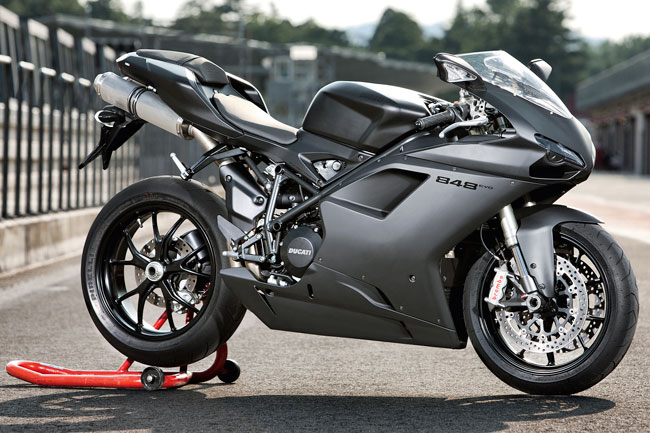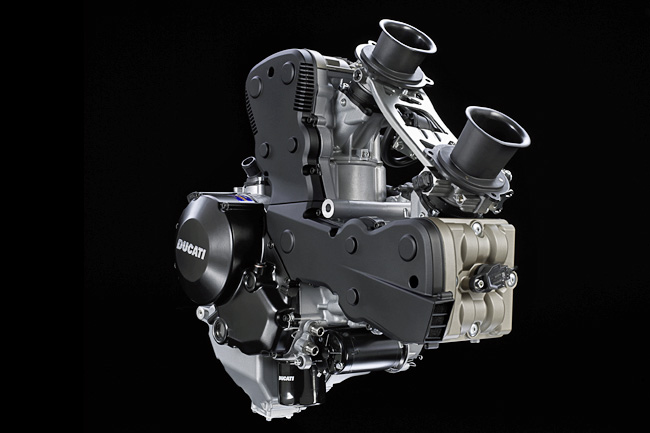Ducati has revealed an up-spec EVO model of the 848 superbike.

Ducati has revealed an up-spec EVO version of its 848 sportsbike for 2011.
The 2011 848EVO now further enhances Ducati’s most impressive lightweight superbike ever with more power from the Testastretta engine and more braking power from Brembo’s incredible Monobloc brake technology combining to provide an even more exciting way to enter the world of Ducati superbikes.
The ‘EVO’ treatment applied to the 848 introduces a six horsepower boost to 140hp (103kW) and a torque increase to 72.3lb-ft (98Nm) that results in a razor-sharp and easy-to-use power delivery while the combination of the 848’s legendary chassis set-up and planet-stopping Brembo Monobloc brakes gives unthinkable braking performances most can only dream of at 168 kilograms.
In pursuit of perfection, Ducati engineers have listened to passionate owners of the 848 superbike since its delivery in 2008 and now enhance its specifications to deliver impressive performances whether riding through mid-town traffic or racing through track-day competition.
Iconic features from the world championship-winning machines, such as the twin under-seat silencers, single-sided swingarm, Trellis frame, beautiful race bodywork and steering damper, are all part of the 848’s DNA.
Its family resemblance assures that it is equipped with all the performance advancements of the superbike family, while adding its own particular character and style.
The early arrival 2011 848EVO is expected to be available from September onwards and maintains the traditional colour of Ducati red with red frame and black wheels and introduces the stunning new ‘dark stealth’ with racing black frame and black wheels.
Engineered by the stopwatch. Designed by the race track
Ducati Superbikes are the most advanced, most powerful twin-cylinder motorcycles ever built. They are the product of a team of designers and engineers who have combined their MotoGP and World Superbike technologies to create the finest sport bikes in the world, and the results are pure excellence. ‘Engineered by the stopwatch, designed by the race track’ is now extended with ‘evolved by experience’ for the 848EVO, as constant owner feedback has been transformed into enhanced specification. Ducati Superbikes are race bikes, pure and simple. Their striking aerodynamic shapes create a natural riding position, confirmed by Ducati development and factory team riders as the optimum for speed and agility. Performance is first and foremost in every detail. Trademark Ducati features like the high tail section and compact front end combine with twin under-seat silencers and single-sided swingarm to express the sheer engineering beauty of aerodynamics and agility.
The 848 Testastretta Evoluzione engine
The new 848EVO is powered by a liquid cooled, L-Twin, Desmodromic engine that produces 140hp (103kW) @ 10,500rpm and a high-accelerating 72.3lb-ft (10kgm) of torque at 9750rpm. The 94×61.2mm bore and stroke breathes through four valves per-cylinder fed by totally revised inlet port shapes and racing-style elliptical throttle bodies, which are now increased in size from an equivalent diameter of 56mm to 60mm.
A brand new piston crown and combustion chamber shape improve burn efficiency and increase the compression ratio from 12:1 to a power-enhancing 13.2:1 while new performance-driven camshafts provide 13mm of valve-lift compared with 11.5mm and an inlet duration increase from 253° to 257°.
These incredible valve performances are made possible because of Ducati’s unique Desmodromic system, where valve closure is activated mechanically. At high rpm it would be almost impossible for the valve to follow the steep closure profile of the cam lobe if it were relying upon a normal valve spring. With the Desmo system, the valve is closed mechanically with the same accuracy as it is opened, enabling steep cam profiles and radical cam timings. This system is used on every single Ducati motorcycle including their world-beating Superbike and Desmosedici MotoGP bikes.
Electronically injected and ignited by Marelli, the super-efficient power unit then exhausts through a lightweight 2-1-2 system equipped with a catalytic converter and up-rated to twin lambda probes for smooth mapping and Euro3 conformity. Terminating in Ducati’s trademark twin under-seat silencers, the system delivers that unmistakable signature sound of the Desmo 90° L-Twin.
The highly advanced 848 engine was the first Ducati Superbike to introduce vacuum die-cast crankcases, formed using Vacural® technology, a process that achieves a significant weight saving and ensures consistent wall thickness and increased strength. For 2011 this impressively lightweight engine has its outer-cases finished in black.
The 848EVO engine is a fitting reward to Ducati’s ingenuity and a clear result of the continual attention to detail and development of their twin-cylinder technology. Having more experience and success with twin-cylinder high performance engines than any other manufacturer, the L-Twin configuration remains central to Ducati’s philosophy of motorcycling. This experience, plus constant investment in quality by design, advanced materials and engineering techniques, has enabled 12,000km between service intervals, making Ducati ownership easy and enjoyable.
Lightweight chassis construction
The 848 chassis and suspension are the result of a ‘performance-first’ priority approach to development, in which the goals are always to achieve lightweight with high strength and rigidity to manage the high-powered Testastretta Evoluzione engines.
Developed in cooperation with Ducati Corse, the lightweight Trellis frame features 34mm main section tubes with a material thickness of 1.5mm. The result is an incredibly rigid construction that remains one of Ducati’s lightest frame solutions ever.
Producing a front subframe in magnesium underlines the attention to weight-saving detail in the Ducati Superbike range. Its construction provides secure support for the headlamp, instruments and fairing, and the weight-saving around this high, forward position contributes considerably to overall ‘feel’ and control of the machine.
The dual construction technique used for the single-sided swingarm allows the main operational components to use individual aluminium castings so as to ensure strength around the pivot points, wheel hub and suspension links, while lightweight, fabricated aluminium sections are used to complete the construction into a single, beautifully engineered component. The 848EVO swingarm is then presented in a sophisticated black-anodised finish.
The lightweight front wheels used on all Ducati Superbike models substantially reduces the moment of inertia, enabling a faster change of direction and enhanced acceleration and braking performances. The 848EVO is equipped with Y-shaped, 5-spoke wheels by Enkei finished in black and mounted with Pirelli Diablo Supercorsa SP 120/70 ZR17 front and 180/55 ZR17 rear tyres.
The 848EVO features fully adjustable 43mm Showa forks with radial brake calliper mountings, which provide superior road holding and precise feedback. A control-enhancing steering damper maintains perfect front-end stability, inspiring supreme control and confidence alongside the increased power output.
The lightweight Trellis frame and single-sided swingarm enable a compact and weight-saving rear suspension linkage system, which features separate lower pick-up points for the push-rod and fully adjustable Showa single shock suspension unit. This ‘tandem’ design effectively reduces stress around the linkage pick-up area of the Trellis frame.
Race-bred equipment
Ducati Superbikes have always been famous for their incredible, track-derived braking performance and the 848EVO is no exception. Now featuring Brembo’s powerful Monobloc calliper racing technology applied to 320mm discs, the EVO’s incredible braking capability is a result of Ducati’s continual quest for responsible performance.
Machined from a single piece of alloy, the callipers achieve a higher rigidity and resistance to distortion during extreme braking. The resulting increase in hydraulic efficiency not only delivers incredible braking power, but also provides an enhanced and precise ‘feel’ at the brake lever. The twin Monobloc callipers each have four 34mm pistons that grip 320mm discs to help generate planet-stopping braking.
Aerodynamic bodywork
Carefully designed for aerodynamic efficiency and to hug the sleek lines of the chassis, the Superbike bodywork enables the rider to blend effortlessly into the correct riding position.
Its race-developed fairing design ensures perfect integration with the cooling system by providing efficient flow through the advanced, large surface area coolant radiator, which is assisted by lightweight, high flow electric fan assemblies and oil coolers. Aerodynamically shaped air ducts positioned just below the headlamps are precisely calculated to provide ample air delivery to the pressurised airbox.
The lightweight bodywork contributes considerably to overall performance by reducing weight, protecting the Testastretta Evoluzione engine’s power output, and assisting the rider to effortlessly ‘tuck in’ from the wind stream and reduce drag to achieve maximum straight-line track speeds.
Instrumentation
This pure racing digital instrumentation originating from Ducati’s MotoGP project has no switches or buttons to compromise its clean, minimalist lines. Instead, information additional to the default read-outs is managed from the left-hand handlebar-mounted switch gear, allowing the rider to scroll through and select from various menus. The display, which has a bright white LED back lighting presents rpm and speed, with the former displayed across the screen in a progressive bar graph.
Optionally, the rpm and speed can be displayed in numeric values. Additionally, it displays lap times, time, air temperature, coolant temperature, battery voltage, two trips and a trip that automatically starts as the fuel system goes onto reserve. Warning lights illuminate to signify neutral, turn signals, high-beam, rev-limit, low oil pressure, fuel reserve, and scheduled maintenance. The instrument display is also used as the control panels for the DDA system (available as an accessory) as well as listing lap times recorded by using the high-beam flash button as a stopwatch.
Data acquisition
The Ducati Data Analyser (DDA) – complete with PC software, a USB-ready data retrieval card and instructions – evaluates the performances of the bike and its rider, and makes comparisons between various channels of information. The DDA is available for the 848EVO as an accessory from Ducati Performance.
Normally only available on race bikes, DDA records numerous channels of data including throttle opening, vehicle speed, engine rpm, engine temperature, distance travelled, laps and lap times. The system also automatically calculates engine rpm and vehicle speed data so as to display gear selection as an extra channel of information. At the end of a ride or track session, an upgraded 4mb of data can be downloaded to a PC ready to compare, analyse and get an inside view of the performance of the rider and motorcycle.
Data can be analysed in graphic form with options to zoom into detail of specific sections. Dragging a trace along a timeline to reveal individual values of the above listed channels enables the user to analyse performance in the same way that data technicians can in factory teams. The software allows data to be compared with that from a completely separate session and for pages of data to be printed off easily.
Superbike lights and indicators
The horizontal twin headlamps are modernised interpretations of the iconic 916, restyled and updated with the latest lighting technology. Two polyellipsoidal units light the way with a powerful beam while maintaining an aggressive look to the front of the machine in pure Ducati Superbike tradition. The rear light employs a specially designed strip of LEDs enhanced by a high diffusion lens shaped into the sleek lines of the tailpiece. The same LEDs are intensified for brake lights. The directional indicators also use the latest in LED technology for illumination. The frontal indicators are beautifully integrated into the rear view mirrors, which come with an optional spacer kit enabling an extension of 30mm over the standard mirror stem length.
Pricing
To be announced closer to the anticipated September arrival.
Visit www.ducati.com.au for further information.

The new 848EVO engine has a six horsepower increase over the original model.







Newsletter